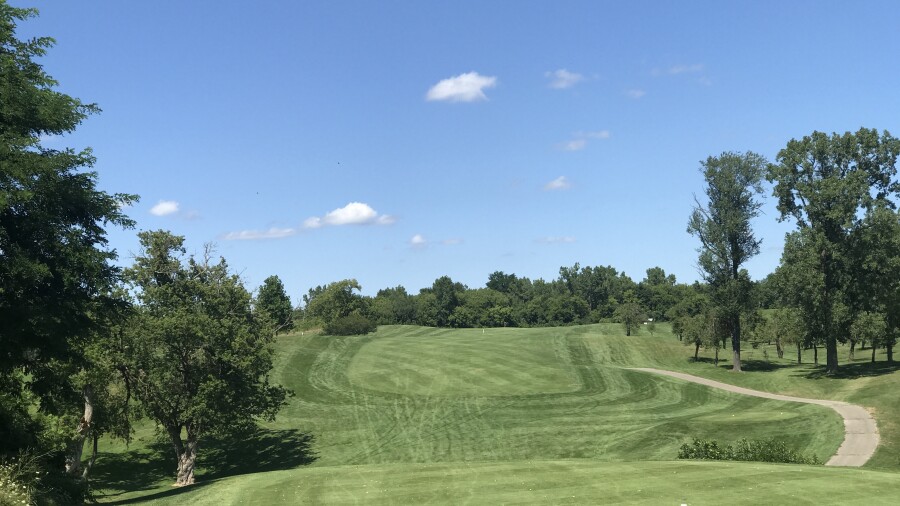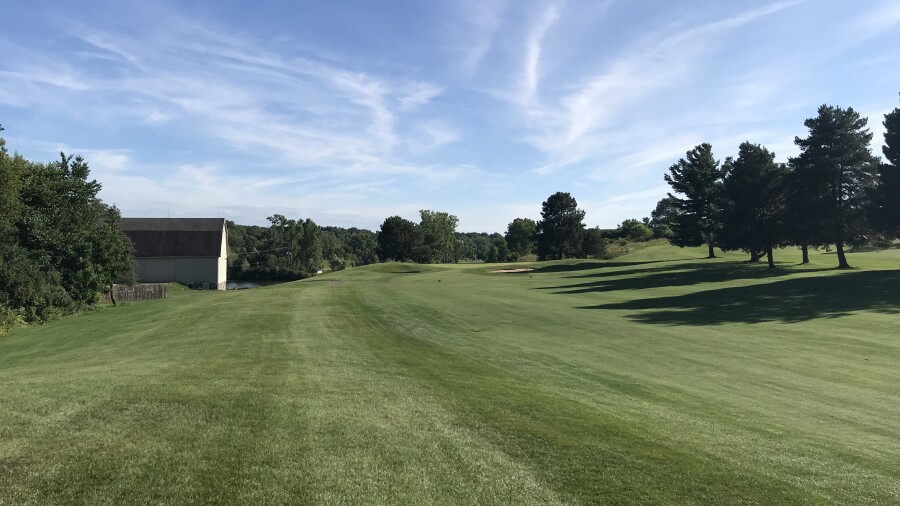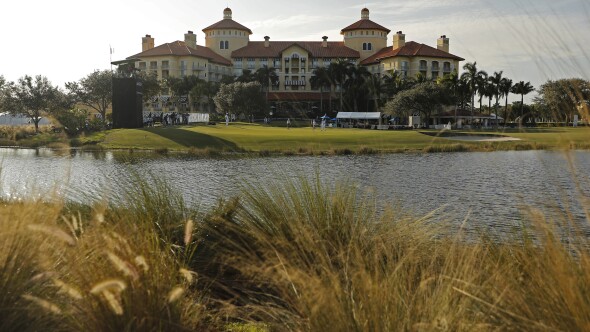ANN ARBOR, Mich. — There won't be any Big House roars this fall due to the Big Ten conference postponing 2020 fall athletics.
The impact to both the economy and general mood of Ann Arborites will be profound. If there's a bright side, it's that there will be no tailgaters scuffing up the Alister Mackenzie-designed golf course and Saturdays will be freed up for some golf.
I'm quite familiar with the Ann Arbor area's golf scene given that I grew up here, worked at several clubs and had junior or high school matches at practically every area course. It had been quite some time since I played anywhere though. A recent tour through the Ann Arbor-Ypsilanti area revealed a golf market that is a little leaner than in year's past but those courses that survived the recent economic downturn and golf course oversupply battles appear stronger now.
Here's the best news for public golfers without local private hookups: Access to a trio of the most prestigious and historic area clubs have loosened up, making Ann Arbor easily one of the best college towns for a golf trip.
Ann Arbor's A-List golf courses

Ann Arbor has served as a hub for big golf events in recent years. Private Barton Hills Country Club, the town's old-school Donald Ross-designed club, hosted the U.S. Women's Amateur in 1998. On the west side, the modern Travis Pointe Country Club is now an LPGA host of the Volvik Championship. (Access to both of these courses is limited to member invite or reciprocal club pro-to-pro arrangements.)
But just about everything in town is in the University of Michigan's orbit, and Big Blue's golf allure is mighty. The athletic department has two excellent golf facilities. Traditionally, the historic University of Michigan Golf Course has only been open to faculty, staff and students, while their Radrick Farms club was fully private. While still generally true, in 2015 the university began offering limited access through their Mackenzie-Dye golf package if you're willing to pay a green fee of about double of any other area course ($125-150 per course or $215-260 to play both).

Near the heart of the city, the Mackenzie-designed U of M course is one of the great college layouts in the country despite busy roads on three sides, so expect a car-honk or heckle in your backswing (I may have been guilty of this as a teen). The par-5 3rd hole is one of the coolest holes in the state, and frankly was my first introduction to exceptional golf course architecture. It heads over a crest off an elevated tee, then bends downhill left and back up to a tucked away, sliver of a green. On the 18th hole, enjoy the elevated tee shot and view of Ann Arbor and try not to flub your approach into the big pond guarding the green - this is always a busy place with tons of onlookers, some of whom may be dignified alumni milling around the new clubhouse.
By comparison, Radrick Farms, east of town off of rural Geddes Rd., is spread out and quiet. It was one of Pete Dye's earliest works, opened in 1965. U of M standout golfer Bill Newcomb recommended Dye for the job and his assisting in the project would eventually spark a design career of his own in the state. Radrick is generally more subdued than Dye's later style - the gentle farmland lends itself to it - and holes 8 and 9 are back-to-back short par 4s, pretty rare for the Dye portfolio.
Booking Michigan's Mackenzie-Dye package: Radrick is technically private, and UM is immensely popular with student play and loads of outings. UM's landing page for the package lists an email address that was unresponsive to my inquiry. To book the UM course, call the golf shop (non-affiliated golfers can book up to 30 days in advance). To book Radrick, email radrick1965@umich.edu within 14 days of your requested date of play.
Suffice to say, neither of Michigan's courses are "one click to book" for guest play. You'll need to work the horn and hope the stars align around dates to play both.
If your tee time inquiry is given the Heisman, never fear, Ann Arbor has other solid options.
Historic Washtenaw Golf Club goes public, plans restoration

Here's a new wrinkle to public-access golf in Ann Arbor. Washtenaw Golf Club, founded in 1899, has undergone a couple ownership changes in recent years and is now a welcoming public facility ($65 weekends w/cart). An ownership group that includes local golf instructor Dave Kendall, of the Golf Channel-affiliated Kendall Academy at the Miles of Golf golf shop and driving range around the corner, acquired the property at the beginning of 2020 and is working with Michigan-based architect Ray Hearn on a restoration master plan.
Washtenaw is a charming walk with fabulous bones on a 120-acre, gently rolling parcel of land highlighted by a collection of par 5s that still hold up all these years later. The architect was unknown until recently, when Michigan golf historian Anthony Ghotz uncovered it was HW "Bert" Way, who laid out the original nine holes in 1899, and John Sweeney extended it to 18 holes in 1922.
There is some wonderfully flowing movement in Washtenaw's terrain. At just 6,512 yards from the back tees, with a forward set recently reconfigured to a friendlier 4,700 yards, it's a tactical course and small ponds require at least three layups off the tee. One of the bolder looks is the 8th hole, a short par 4 that heads up a steep slope. Modern, longer hitters can potentially reach the top shelf green while shorter hitters are faced with an all-blind approach.
Like many old clubs, Washtenaw's layout has grown over-treed and some of the greens have shrunk or lost their intended shape over 100+ years. In its current state, it's still the best public experience in Ann Arbor, but the right TLC gives it the potential to be an elite historic course you can play. The main goals over time will be to return some of the greens to their original shape (many of which had square edges) and a hefty dose of tree management.

Improvements at Ann Arbor's two municipal golf courses
The City of Ann Arbor has two municipal golf courses and as of 2020 they are in top nick, better than at anytime I can recall during my childhood schlepping them every day. Each have achieved Certified Audubon Cooperative Sanctuary in the past 10 years and a return visit reveals more native areas in non-golf-corridor areas.
Leslie Park Golf Course, originally built in the 1960s by Larry Packard and renovated in the 90s by Arthur Hills, is considered among the state's best municipals. Located just north of town on a quiet and hilly setting whose nines are separated by a dirt road, the whole course and especially the back nine has been enhanced in recent years with an Audubon-certified water quality improvement and beautification project that brought a host of wildflowers to the creeks, ponds and low-lying areas. It makes for colorful ground throughout.
There are some tough looks on the front nine, like the daunting 6th that plays uphill and kicks balls that land on the right edge of the fairway into an orchard. A highlight of the round is the par-3 17th played over water with the tee box next to a barn. It's a hilly course to walk, but possible as long as you're up for a steep incline to the 14th hole. For 2020, Leslie leased a fleet of Club Car Tempo Walks that have been popular.

If your group likes a casual afternoon knockabout, consider the city's historic Huron Hills Golf Course. This 5,071-yard, par-67 layout dates back to 1922 with design credit by Tom Bendelow and while it doesn't earn the type of national short-course acclaim as other similar facilities, it's a great vibe full of juniors and in considerably better condition than my early golf days spent here. If you don't have time or energy for 18, try and play the back 11 holes on the hilly side of Huron River Drive. There are four, sub-300-yard par 4s combined with some tough, long par 3s. The 9th and 18th holes have elevated tees where you can swing for the distant hills across Huron River. At just $19 walking for 18 holes, it'd be a fun match-play course on a twilight evening.
EMU's Eagle Crest gets more revealing

Bordering Ann Arbor's east side is Ypsilanti, a smaller but similarly old and leafy college town home to Eastern Michigan University with a charming Depot Town district in the historic core (during COVID the street blocked off allowing for spacious al fresco dining). Minutes south, EMU operates Eagle Crest Golf Club, and while their course (est. 1987) may lack the architectural pedigree of U of M's fabled courses, it wouldn't swap its scenic setting on Ford Lake with either. In 2012 EMU embarked on a 20-year-master plan to the course to elevate its stature amongst the NCAA. They've come along way since my previous visit in 2006 with three new greens built, tree clearing along the lake and more subtle enhancements to the resort golfer, as well as making it a stiffer test for the Mid American Conference player.
We highlight a lot of collegiate golf courses that have received total makeovers. Meanwhile, Eastern Michigan University is chopping wood on a 20-year master plan at their Eagle Crest course in Ypsilanti.
— Brandon Tucker (@BrandonTucker) August 13, 2020
Found an old photo from 2006 of No. 14 vs. 2020: pic.twitter.com/hzc9aUBIpR
An elevated tee on the first hole darts straight towards the lake and the elevated 2nd green sits on an exposed site beside its lapping shoreline. There are some wonderful holes on the back, like the low-lying 12th, but its the signature par-5 16th hole that is the climax: a reachable par 5 for big swingers that hugs Ford Lake tee to a narrow peninsula-green.
Eagle Crest green fees are also very competitive at $67 prime-time weekend with cart and plenty of weekday tee times less than $50. Located right off I-94 between Detroit Metro Airport and Ann Arbor, a round makes a lot of sense on arrival day, especially given its resort-style service and amenities (color GPS and USB in cart) and scenic, elevated driving range overlooking the course and lake. If you need a stay-and-play option, the Marriott Ypsilanti Eagle Crest overlooks the course.
More golf in and around Ann Arbor

When Stonebridge Golf Club opened on the west side in the mid-1990s, it brought the modern, residential development golf boom to Ann Arbor. It's a pretty tough and showy layout by Arthur Hills. Across the street, Lake Forest Golf Club opened about 10 years later and is a core-golf facility with lower green fees.
About 20 minutes north of Ann Arbor in South Lyon is Moose Ridge, which opened in 2000 and boasts a Ray Hearn design that has a forested feel with little neighboring development. Also in South Lyon is Cattails, another 1990s facility that is very secluded and natural-feeling. 27-hole Tanglewood opened in 1991 and is a solid upscale daily-fee course designed by Michigan-based architect Bill Newcomb. It has some nice touches like a replica Mackinac Island Bridge on the course.
One of the more hustling public golf facilities in lower Michigan is family-owned Fox Hills in Plymouth. Choose from the 27-hole Classic Fox, 18-hole Golden Fox (Arthur Hills) or 18-hole par-3 course, Strategic Fox. If you want quiet and secluded golf under $50 on weekends, head to the Whitmore Lake Golf Links, which has two very different nines with the back nine playing in deep wetlands.
There are a lot of metropark and county courses within 30 or so minutes of downtown Ann Arbor. West of town in Chelsea on I-94 is Washtenaw County-run Pierce Lake Golf Club, a very scenic layout. It was a welcomed addition to the local scene when it opened in the 1996 and it's good to see it continue to receive strong reviews on Golf Advisor.
In Pinckney, Timber Trace Golf Club also opened in the 1990s and with some holes framed by tall pines brought a dose of that coveted "up north feel" to southeast Michigan with a quiet atmosphere and holes framed by tall pines. If you like cart rides, there is a long one the back nine through woods between holes. | Browse Ann Arbor-area tee times on GolfNow
Ann Arbor golf: When to go
If your golf group is considering a college-town weekend, consider going in June during the city's Top of the Park festival. It runs nightly for about a month in June and is the place to be with live music, good eats and drinks. It's fun for the whole family or a great spot to hang and soak in the townie scene.
Th Ann Arbor Art Fair, typically in mid-July, can choke hotel room supply and roads, but could occupy your non-golfing family members if need be. September and early October is a lovely time to play golf in Michigan amongst fall foliage. Be mindful of Michigan home games and if you'll be there during one, secure accommodations and dinner reservations well in advance and don't be on the road when the game ends or you're fighting 100,000 fans to the freeways.
Ann Arbor Food & Drink
Ann Arbor is a fine foodie and beer town. I'm not a townie anymore, and surely new spots have popped up. I just typically don't go anywhere that wasn't around when I lived here. For sandwiches, Zingerman's Deli in Kerrytown is worth all the hype. I get Dave's Open Road (#74) every time - Amish Chicken, ranch, muenster cheese on Challah. For Pizza, I'm big on Pizza House, an institution in South University (love the subs) that stays open late. On Washtenaw Ave., Paesano's has been around a long time and serves up excellent Italian fare ... I always loved the casual outdoor vibe of Dominic's near campus, which has beer and pizza. And for beer buffs, Ashley's is a great go-to on State Street.


























Nicely researched, photographed, and comprehensively written article about a great, though perhaps unexpected locale for a golf trip. The photos depict courses both attractive and challenging. What I like especially is your coverage of a marquee-styled course (Washtenaw) with lesser-known but perfectly good options. And Arthur Hills ranks among the most underrated architects in America--we don't hear enough about him.
I've played golf in Michigan on a trip some 18 years ago, and the trip was an excellent one. For me, this review of the area is a keeper.
Thanks for the kind words. Michigan is ready for your return visit!